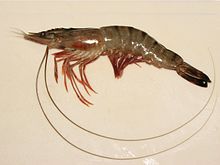Crustaceans may pass through a number of larval and immature stages between hatching from their eggs and reaching their adult form. Each of the stages is separated by a moult, in which the hard exoskeleton is shed to allow the animal to grow. The larvae of crustaceans often bear little resemblance to the adult, and there are still cases where it is not known what larvae will grow into what adults. This is especially true of crustaceans which live as benthic adults (on the sea bed), more-so than where the larvae are planktonic, and thereby easily caught.
Many crustacean larvae were not immediately recognised as larvae when they were discovered, and were described as new genera and species. The names of these genera have become generalised to cover specific larval stages across wide groups of crustaceans, such as zoea and nauplius. Other terms described forms which are only found in particular groups, such as the glaucothoe of hermit crabs, or the phyllosoma of slipper lobsters and spiny lobsters.

